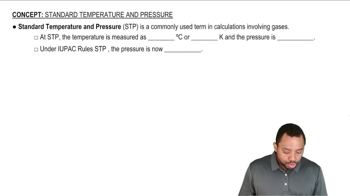Here are the essential concepts you must grasp in order to answer the question correctly.
Ideal Gas Law
The Ideal Gas Law relates the pressure, volume, temperature, and number of moles of a gas through the equation PV = nRT. Here, P is pressure, V is volume, n is the number of moles, R is the ideal gas constant, and T is temperature in Kelvin. This law allows us to calculate the number of molecules in a gas sample by rearranging the equation to find n, which is directly proportional to the number of molecules.
Recommended video:
Molar Volume of a Gas
At standard temperature and pressure (STP), one mole of an ideal gas occupies approximately 22.4 liters. However, the volume occupied by a gas can change with temperature and pressure. Understanding how to convert conditions to STP or use the Ideal Gas Law is essential for comparing the number of molecules in different gas samples under varying conditions.
Recommended video:
The Ideal Gas Law: Molar Mass
Temperature and Pressure Effects on Gas Behavior
Temperature and pressure significantly affect gas behavior, influencing the volume and number of molecules present. Higher temperatures increase kinetic energy, leading to greater volume if pressure is constant, while higher pressure compresses gas into a smaller volume. Recognizing how these factors interact is crucial for accurately determining the number of molecules in different gas samples.
Recommended video:
Standard Temperature and Pressure




